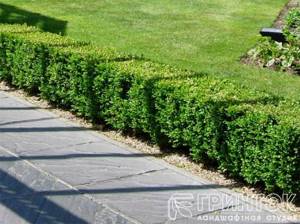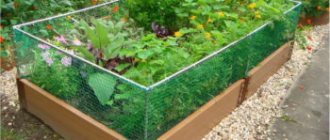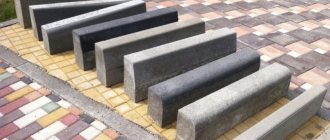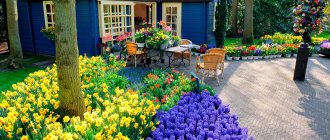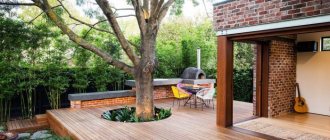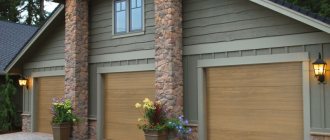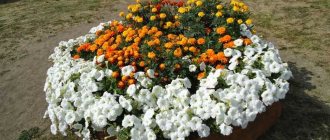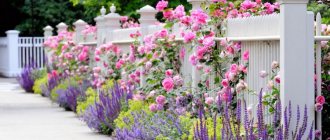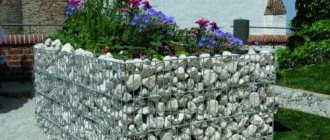Apr 16/14
The garden border is an indispensable element of landscape design. With its help, you can accurately mark the boundaries of flower beds, beds, lawns and flower beds, thanks to which garden paths and the area as a whole acquire a laconic and complete look. However, in addition to the aesthetic function, garden borders perform a lot of practical tasks - they prevent the destruction of the lining, protect the path from grass sprouting and delay the flow of water during rainstorms or watering the lawn.
Modern borders for garden paths are made from a wide variety of materials, including metal, plastic, wood, stone, brick, etc. The choice of material largely depends on the features of the landscape design of the site. However, when installing this element, it is also important to take into account some of their characteristic features. “House of Dreams” will help its readers understand all these nuances today.
Garden borders
Features of metal borders
The design of metal borders consists of entire strips of steel, aluminum or copper. They are installed in the ground strictly along the contour of the lawn, protecting the path from grass and weed germination, as well as clearly marking their boundaries.
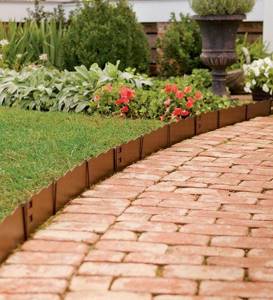
Garden metal borders
Thanks to its simplicity and conciseness, a metal garden border fits perfectly into the appearance of any landscape design. This design is especially harmonious for areas with strict lawn geometry. It is also recommended to use metal curbs to enclose crushed stone paths.
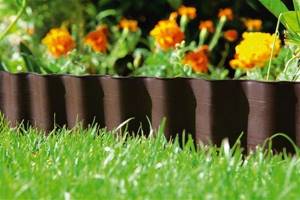
Garden metal borders
Choosing shrubs for a living border
For those gardeners who prefer consistency, low-growing, dwarf varieties of decorative deciduous shrubs are suitable for constructing border hedges. To create a dense, trimmed border about half a meter high, choose such low-growing species as barberry, boxwood, cotoneaster, caragana, cinquefoil, honeysuckle and many other plants.
Dwarf varieties that can be used to make a wonderful living border include:
Barberry boxwood. The evergreen shrub retains its decorative value all year round. The plant is notable for the fact that it grows on any soil and develops well both in the shade and on the sunny side of the garden. This barberry variety responds well to pruning and also holds any garden shape well.

Barberry boxwood trimmed
Boxwood, cultivar Buxus sempervirens Suffruticosa, grows slowly. The evergreen shrub is decorative throughout the year. The luxurious shiny dark green foliage gives the plant a special charm. Boxwood is an excellent option for creating ceremonial borders. It cuts perfectly and retains its shape for a long time. Other varieties of boxwood are also suitable for these purposes, both with green foliage and variegated ones. This plant tolerates shade and drought well. But for the winter it is better to cover it to avoid sunburn in early spring.
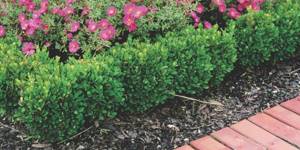
Evergreen boxwood 'Suffruticosa'
Euonymus Fortune. This plant is well suited for wide and low borders. A slow-growing, very low shrub that practically creeps along the ground. Long shoots grow up to three meters in length, covering the soil around them. The branches are covered with numerous leathery leaves ranging from 3 to 5 centimeters in length. To arrange living borders, you can use different varieties of Euonymus Fortune, which have white-green foliage with pink veins. The plant is drought-resistant, grows well in partial shade, and tolerates pruning well.
Read also Do-it-yourself change house step by step photo instructions
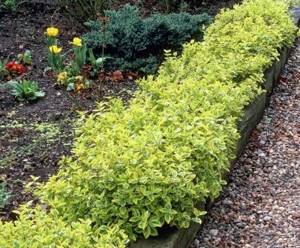
Euonymus Fortune
Caragana is better known to us as acacia. If you don't cut it, you can end up with a thorny, impenetrable hedge. Caragana orange is suitable for arranging low borders. Its bushes grow no more than 1 meter. The crown is loose and spreading. If you regularly trim this unpretentious plant, you can get a fairly dense living border.
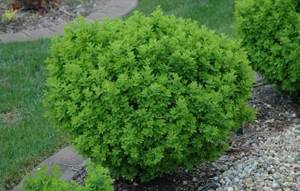
Caragana shrub "Globosa"
Honeysuckle is a semi-evergreen plant. Its lodging branches are densely covered with shiny oblong green leaves. It is undemanding in terms of soil composition and grows well in both sun and partial shade. This plant loves warmth. Therefore, in regions with a fairly harsh climate, honeysuckle sheds its leaves in the winter and may freeze. To protect shrubs during cold weather, shelters are made.
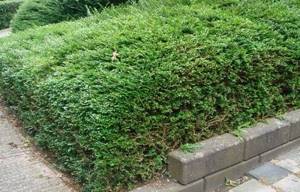
Honeysuckle brilliant
Rhododendron. For borders, low-growing varieties with a compact crown are chosen. Among all the variety of colors and shapes, it is quite easy to choose shrubs with excellent decorative properties. But for any variety of rhododendrons it is necessary to create acceptable conditions. They love sun or lacy partial shade, and also require protection from cold northern winds. Shrubs will grow well in acidic, well-drained soils. Evergreen varieties need shelter from the bright spring rays of the sun. Otherwise, they will suffer serious burns.
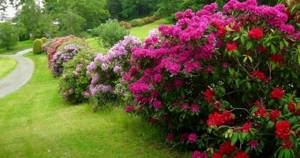
Rhododendron (Azalea)
Mahonia holly looks great both natural and trimmed. The border of this evergreen shrub is decorative all year round. All the beauty of this plant lies in the foliage, shiny and juicy. The serrated dark green leaves turn purple in the fall. In spring, the bushes are decorated with yellow flowers, and in winter the mahonia leaves, strewn with whole bunches of blue-black berries. This plant loves moisture, grows well in sunny areas, and requires shelter in the winter. To get a beautiful trimmed border, mahonia should be pruned in the spring after flowering, or in the fall.
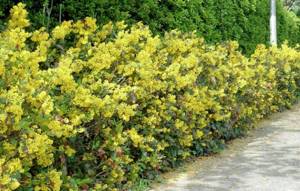
Mahonia holly
Choosing plastic borders for the site
Plastic borders for garden paths have many advantages. Firstly, their affordable price, secondly, high durability, which is ensured by especially durable plastic material, and thirdly, plastic borders are very easy to install.
To install these elements, there is no need to dig a trench, prepare a foundation or use special fasteners. Installation of plastic curbs is carried out using anchor pins, which very firmly fix the structure. In addition, the lightness and plasticity of borders made of this material makes it possible to lay them along curves and winding lines. However, despite their lightness, such borders perfectly fulfill their main tasks - they strengthen the contours of the paths and prevent the growth of grass.
Plastic curbs can be installed along the contours of paths with absolutely any surface. Due to the external “invisibility” of their design, takei borders will perfectly complement any landscape design style.
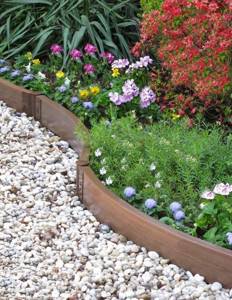
Plastic garden border
Where and why can you use green or flower borders?
They have several functions:
- they visually highlight the object that they frame: a path, platform, pond, flower bed or flower garden;
- when framing paved paths and areas, they form a smooth transition to greenery and protect against soil blowing onto the surface: when using such borders, the area will be cleaner. Moreover, they can be combined with a standard curb stone;
- provide wind protection for vulnerable plants. This is especially important if capricious annuals will be grown behind the border line: a higher frame will protect them from the wind until they get stronger;
- in park areas, green areas are protected from trampling: a dense, fairly high and wide border replaces a fence well. It can perform the same protective function if pets are walking on the site.
Flower and green borders are planted to decorate the following objects:
- flower beds, flower beds, ridges. For them, borders become either a transitional element or part of the design;
- lawns. With the help of border landscaping, they are separated from paved areas, park landscaping areas, from an orchard or vegetable garden;
- areas for recreation, games, and sports. Shrubs of medium height are planted along their perimeter to provide wind protection and highlight them visually. For playgrounds, children's playgrounds, and sports grounds, border landscaping can be used for additional protection from noise;
- small architectural forms. Flowers are planted around the perimeter of gazebos, along benches, around fountain or sculptural groups to further highlight them and improve their appearance;
- walkways, stairs, driveways. Green borders highlight them and make the transition between the paved surface and the landscaping area smoother.
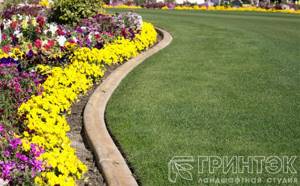
Wooden garden borders
Wooden borders not only protect paths from creeping, but also emphasize their appearance, giving the area an interesting expressiveness. Wooden borders for flower beds, lawns and flower beds can be made in a wide variety of shapes and designs.
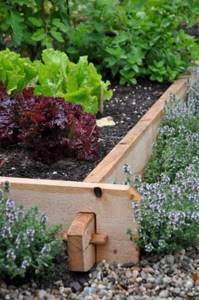
Borders for flower beds made of wood

Wooden borders for garden paths
The simplest option for creating wooden borders is to lay specially treated boards along the edge of the paths. This option is not the most reliable in terms of strength, but if you are thinking about how to make a border for paths yourself, then start with a wooden structure.
Also, wooden borders are often made in the form of driven boards or bars installed longitudinally. The most important advantage of wood from a decorative point of view is the ability to paint this material with any colors, create designs using paint and firing, as well as bring to life any shape and independently adjust the height of the structure. In addition, wooden borders perfectly complement any landscape design and harmoniously combine with a variety of garden accessories and decorations.

Wooden garden borders
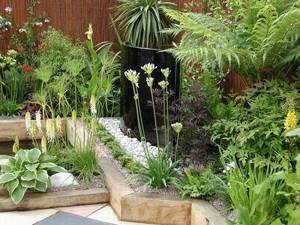
How to make a border for paths
However, when choosing wooden borders for summer cottages, keep in mind that their service life often does not exceed 10-12 years, even with regular treatment with antiseptic agents.

Wooden border for vegetable garden
Materials for production
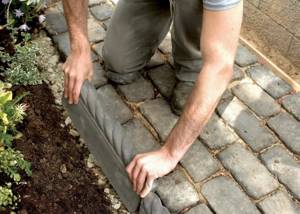
The variety of types of borders for flower beds, as well as the materials from which they are made, are determined by their functionality. They are (see photo):
- lightweight design;
- concrete;
- stone;
- brick;
- made of metal;
- from synthetic materials;
- made of wood;
- from scrap materials.
Lightweight structures that act as fencing have a decorative function. You can purchase them or make them yourself from scrap materials. Willow rod is suitable for such structures. With its help, low and small fences are made, which, like a basket or miniature village parsing, frame a flower garden or flowerbed.
Concrete

Concrete structures are an option for tall, large, wide flower beds. They do not just enclose a piece of soil, but serve as a support and barrier for it. Concrete curbs are:
- full-bodied;
- from hollow blocks;
- combined.
On a note!
Hollow border blocks are good because in them (in the center of each block) you can plant additional plants, put pebbles or shell rock.
They don't look as bulky as a solid concrete block. Concrete curbs are often combined with wooden beams or metal. Combined designs look original, fresh and modern.
Stone
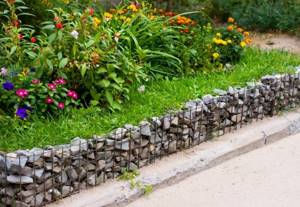
A stone border is good for any garden plot, especially since you can find a stone in the same area and make a frame for flower beds with your own hands. The stone used is:
- jackdaw;
- gravel;
- wide flat stones (they are placed on edge, leaning close to each other);
- pellet (wild smooth stone);
- large boulders.
The stone goes well with wood, glass, metal, tiles (or fragments of glass, tiles, fragments of tiles, cement); it can be used to create a dry stream or, if the area of the site allows, a stream with real water.
Brick
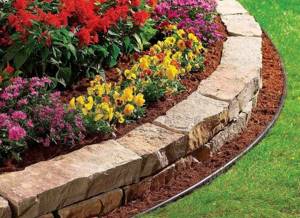
A brick border is an alternative to stone or concrete. For it, you can use either a whole brick or what remains from the renovation or construction of a summer house, that is, fragments or halves of a whole. Brick can be strengthened:
- additionally filling with cement mortar;
- cover with tiles, mosaics;
- make inserts from multi-colored glass;
- use different masonry methods;
- put on edge.
A fencing for flower beds, made from brick with your own hands, can be painted in the color of the cottage or left as it was.
Metal
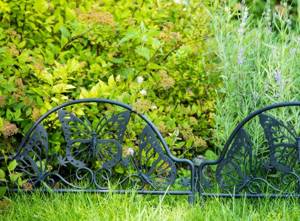
Forged metal fencing for flower beds, purchased or made to order, can complement the design or decoration of the house if they have openwork forged elements. There are also solid metal flower beds on sale, into which you can pour soil and plant flowers.
It is possible to make a border for a flower bed with your own hands (photo in the gallery), however, it is better to purchase a finished product. Durability and unique appearance are what distinguish flower garden fences made of metal.
This option is not cheap, but it is one of those that lasts for centuries.
Synthetic material

Synthetic materials allow you to save a lot when framing flower beds and flower beds. If desired, such a border can often be replaced with a new one, or moved from one place to another. The plastic or resin from which modern fencing is made can withstand temperature changes and will not fade or deform.
Plastic borders can be made:
- In the form of a tape wound into a roll. Rolled tape is easy to cut and takes the desired shape.
- In the form of separate sections that are connected or not connected to each other and stuck into the ground.
- In the form of imitation wood, tiles, stone or brick.
Might be interesting Do-it-yourself blind area around the house: options, step-by-step instructions with photos Pros and cons of houses made of profiled timber Do-it-yourself flower beds made from tires: step-by-step instructions with photos
A flexible border for a flower bed is used to strengthen or delimit a flower bed of any curved shape or winding path. You can strengthen the soil with border tape by drowning it at the level of the roots of the plant.
You can use a plastic curb “stone” in the same way. Such a fence prevents flowers from creeping out of the flowerbed.
Separate sections of plastic borders are:
- openwork;
- in the form of fences, wickerwork;
- in the form of grass and flowers.
- whole.
With them you can realize any design ideas and frame a flowerbed that does not require serious support or protection from children and pets.
Note!
Plastic fencing for flower beds, imitating natural materials (wood, stone) and man-made (brick, finishing tiles, tiles) is an inexpensive option, suitable for those who like to save money, as well as for those who do not want to allocate a large budget for decorating a small plot of land.
Tree

Wood is also used to create a border around flower beds. This material performs several functions at once:
- Protects flowers from pets.
- Protects the soil from being washed out of the flower bed during heavy rains.
- Performs a decorative function.
A decorative fence can be installed around a flower bed, along a path, or used to decorate the driveway composition of a personal plot. A material such as wood allows you to realize any idea.
Made from wood:
- palisades of any height;
- multi-tiered structures;
- combined fencing (timber + sawn timber, timber and concrete, sawn timber and metal, timber and brick).
If desired, the wood can be left as it is, that is, in its natural color, or it can be painted in different colors or covered with stain. But it is imperative to treat it with special coatings that protect the wood from rotting and insect damage. Properly treated wood will last for many years. Without treatment, the tree, fixed in the soil, begins to rot.
Other materials at hand

One of the budget versions of constructing a border for a flower bed is the option of making it from improvised materials. Often such options seem to be a temporary solution, but they take root on the site so well that everyone else follows their style. The material at hand is something that is lying in the barn at the dacha, that it is a pity to throw away and you want to use somewhere when an idea comes:
- boards of different sizes;
- used car tires;
- Rabitz;
- plastic and glass bottles;
- plates, trays, ceramic dishes;
- shells brought back from vacation from the sea;
- scraps of metal pipes;
- wooden or metal wheels from a cart.
What the border will be like will be determined by the shape of the flower bed and its place on the site.
Natural stone borders: simple and natural
Perhaps the most fundamental and aesthetically attractive are borders created from natural stone. Such borders are great for decorating flower beds, flower beds and lawns of any shape. However, such an option for decorating borders can hardly be called budgetary, because, firstly, the natural material itself is not cheap, and, secondly, the installation of borders made of natural stone requires careful preparatory work.
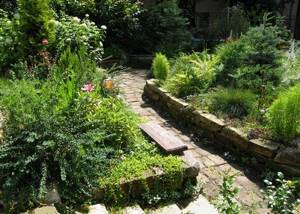
Natural stone border
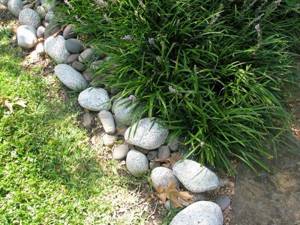
Border made of large pebbles photo

Borders made of large stones photo
A stone border can be created using marble, sandstone, artificial or natural granite, pebbles or limestone. Stone granite is most harmoniously combined with paths made of smooth paving slabs, paving stones or stone. To create a holistic picture of landscape design, stones of the same size are placed close to each other.
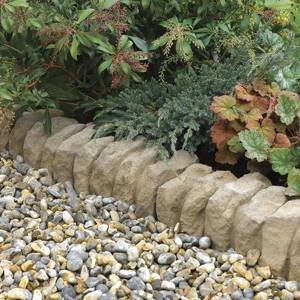
Natural stone border
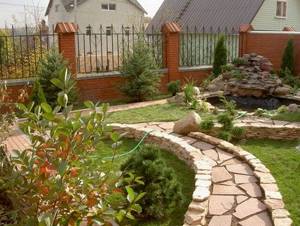
Natural stone border in landscape design
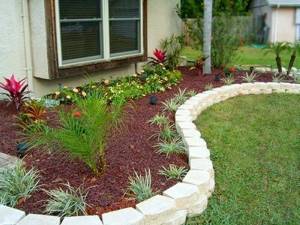
Natural stone border in landscape design
Materials from the granite workshop “Pamyat M”
The main specialization of the company is the production and installation of monuments, borders and tiles in the cemetery on a turnkey basis. You can order grave frames from us in different price categories. The most economical option is concrete products. They are used when laying gray or red paving slabs, when installing grave fences, and filling the area with crushed stone and gravel.
A more expensive, sophisticated and durable variation is a granite gravestone border. It is suitable for edging granite surfaces (tiles, paving stones, crushed stone or chips). You can insert fences into it. In stock - Karelian gabbro-diabase, as well as imported products of various colors.
Marble also belongs to the elite group of natural materials. It looks great and is not afraid of moisture and frost. However, the sun has a destructive effect on it, and dust penetrates deeply into the pores. Therefore, marble borders require regular treatment with protective agents.
Borders for flower beds with imitation stone
As you know, natural stone is an expensive pleasure if it is not collected from nature. Therefore, owners of household plots and garden plots often resort to such a solution as imitation stone. Moreover, borders made of artificial stone look very neat and aesthetically pleasing, harmonizing perfectly with lush greenery and flowers. And caring for them is quite simple and not troublesome.
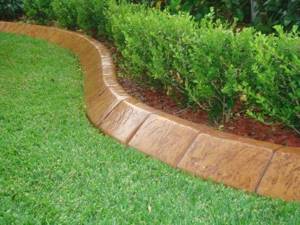
Decorative stone border

Artificial stone garden border
Making a border for flower beds from tape step by step

A border for a flower bed can be easily made from border tape. This type of work does not require preparation or special tools. You will need: tape of the desired color and width, a knife or scissors, a stationery or garden stapler with large paper clips.
- Unwind the tape and leave it in the unrolled position. This makes it easier to take the desired shape, becomes more pliable and cut.
- Dig a narrow ditch around the flower bed. Its depth depends on the plant species. If plants are planted in a flowerbed, the roots of which grow and spread, then the depth should be such as to protect the roots and prevent them from creeping out of the flowerbed area.
- Place the tape in the groove and cut it to the desired length.
- Secure the ends with staplers.
- Cover the resulting border with soil and compact it well.
Decorate with available materials: pebbles, branches, moss, etc.
Simple garden borders made of bricks
A very popular material for creating borders is facing brick. Brick curbs harmoniously complement paths made of paving stones, crushed stone and other materials.
Most often, the brick is laid along the line of the garden path at a slight angle, in the form of oblique teeth. Installation of brick borders is quite simple and not labor-intensive. However, despite the relative strength of facing bricks, this material is not entirely suitable for areas with frequent rainfall.
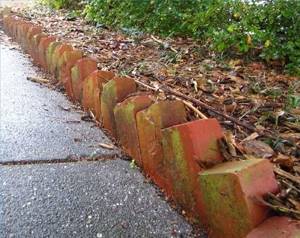
Brick garden borders
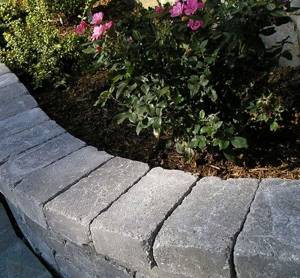
Brick garden borders
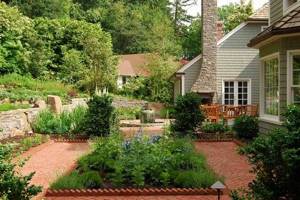
Brick borders photo
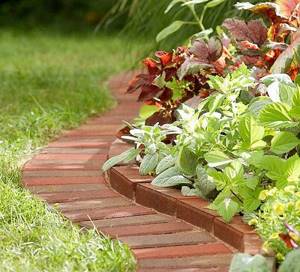
Borders made of facing bricks photo
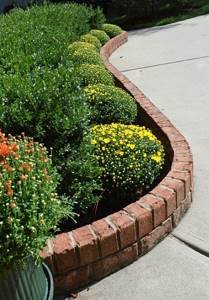
Brick garden borders photo
How are border plantings done?
There are several special techniques for creating a neat and beautiful border of flowers, shrubs or herbs.
Border plantings should be contrasting if you want to draw attention to a flower bed, gazebo or fountain group. If the border smoothes the transition between different functional areas, it is formed avoiding contrast. More often, flowers of calm colors or shrubs are used.
The height of the border is no more than 40-50 cm, the width is 30-50 cm. The dimensions are determined by purpose. If they frame a park area, separate the garden from the sidewalk or roadway, and must provide wind protection, taller shrubs with dense, dense branching can be used. If planting is carried out along a flower bed, the plants should not hide it; it is better to use low-growing shrubs or flowers.
For border plantings, compact plants that grow slowly are used. If these are shrubs, they should tolerate pruning well (especially if their shape must be strict). Plants are planted tightly. If these are cereals or flowers, they can be sown in “rows” in several rows.
